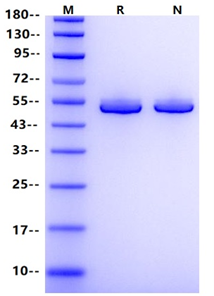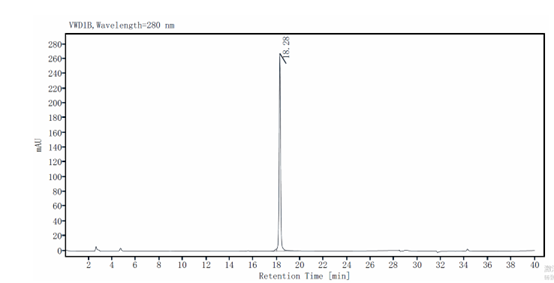Gly2-Ser427, with N-terminal 8*His HHHHHHHHHHDYKDDDDKKRAAAKHLIERYYHQLTEGCGNEACTNEFCASCP HHHHHHHHGTPKPRILPWLVSQLDLGQLEGVAWVNKSRTRFRIPWKHGLRQDAQQEDFGIFQAWAEATGAYVPGRDKPDLPTWKRNFRSALNRKEGLRLAEDRSKDPHDPHKIYEFVNSGVGDFSQPDTSPDTNGGGSTSDTQEDILDELLGNMVLAPLPDPGPPSLAVAPEPCPQPLRSPSLDNPTPFPNLGPSENPLKRLLVPGEEWEFEVTAFYRGRQVFQQTISCPEGLRLVGSEVGDRTLPGWPVTLPDPGMSLTDRGVMSYVRHVLSCLGGGLALWRAGQWLWAQRLGHCHTYWAVSEELLPNSGHGPDGEVPKDKEGGVFDLGPFIVDLITFTEGSGRSPRYALWFCVGESWPQDQPWTKRLVMVKVVPTCLRALVEMARVGGASSLENTVDLHISNSHPLSLTSDQYKAYLQDLVEGMDFQGPGES
48.2kDa
Reconstitute at 0.1-1 mg/ml according to the size in ultrapure water after rapid centrifugation.
1.J Cell Sci. 2019 Jul 24;133(5): jcs230409.
2.Science.2020 Oct 23;370(6515):eabd4570. Epub 2020 Sep 24.
3.Immunity. 2006 Sep;25(3):349-60.
4. Proc Natl Acad Sci U S A. 2016 Jun 14;113(24):E3403-12.Epub 2016 Jun 2.
5. Biochem Pharmacol. 2006 Nov 30;72(11):1469-76. Epub 2006 Jul 17.
Regulatory factor (IRF) family - IRF-3 is the key transcriptional regulator of type I interferon (IFN)-dependent immune responses which plays a critical role in the innate immune response against DNA and RNA viruses. IRF3 regulates the transcription of type I IFN genes (IFN-alpha and IFN-beta) and IFN-stimulated genes (ISG) by binding to an interferon-stimulated response element (ISRE) in their promoters. It acts as a more potent activator of the IFN-beta (IFNB) gene than the IFN-alpha (IFNA) gene and plays a critical role in both the early and late phases of the IFNA/B gene induction. IRF3found in an inactive form in the cytoplasm of uninfected cells and following viral infection, double-stranded RNA (dsRNA), or toll-like receptor (TLR) signaling, is phosphorylated by IKBKE and TBK1 kinases. This induces a conformational change, leading to its dimerization and nuclear localization and association with CREB binding protein (CREBBP) to form dsRNA-activated factor 1 (DRAF1), a complex which activates the transcription of the type I IFN and ISG genes. It can activate distinct gene expression programs in macrophages and can induce significant apoptosis in primary macrophages.

2μg (R: reducing conditions, N: non-reducing conditions).


Immobilized IRF3 His Tag, Human (Cat. No. UA010640) at 2.0μg/mL (100μL/well) can bind IRF3 Recombinant Rabbit mAb (S-449-24) (Cat. No. S0B0598) with EC50 of 0.59-0.92ng/mL.